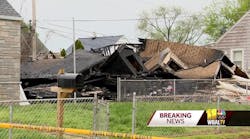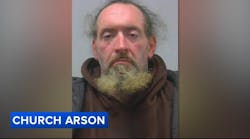Nov. 25--The alarm sounds, and the fire engine from Colorado Springs Fire Station 8 zips out of the garage and speeds off toward a nearby apartment complex. Not because the building is on fire, but because a tenant doesn't feel well.
The patient is having severe pains that run from her lower sternum to her back. She tells the paramedic she has Crohn's disease and an inflamed pancreas.
"Have you seen a doctor for Crohn's recently?" asks paramedic Kevin Apuron.
"No," she says.
"Should you be on meds that you're not taking now? he says, examining several prescriptions on her dresser that are well past their expiration date.
"I don't know," she replies.
As the woman is loaded onto an ambulance, Apuron shakes his head and tells a colleague that she probably wasn't following the most Crohn's-friendly diet, judging from the crumpled junk food wrappers in a wastebasket near her bed.
But this is nothing new for Apuron and his colleagues at Station 8 in southeast Colorado Springs. Day in, day out, they respond to 911 calls that have nothing to do with fire, and everything to do with people who, for whatever reason, rarely get the kind of preventive medical care that might keep them from calling 911 in the first place.
In fact, it's the norm at most fire stations in America, where medical calls can account for at least 70 percent of a fire department's workload. In Colorado Springs, 78 percent of emergency calls to the fire department are for medical issues, and most are not imminently life-threatening, says Jeff Martin, community and public health administrator for the Colorado Springs Fire Department.
Some are from people who have run out of their medication or want their vital signs checked.
Some are from people who have no way to get to a doctor, or have no primary care doctor at all.
Many are "frequent fliers" -- people who call 911 repeatedly for non-critical care. It's as if the shiny red fire truck with its ladders and hoses and firefighting equipment is primarily a vehicle for making house calls.
Against that backdrop, the Colorado Springs Fire Department is looking to deploy some of its resources and partner with community medical and safety-net organizations to better address residents' health needs, hook them up with primary care, and encourage them to take care of their own medical needs before they get to the point of having to call 911.
"They don't know how to access care," Martin said. "In some cases, it just gets to the point where they're uninsured, they can't afford to get care, and they wait and wait when it could have been fixed for a $20 antibiotic."
Long-range, the department is looking at setting up health clinics at fire stations in areas where people are likely to be uninsured or underinsured. It will be at least a year before the first full-fledged one opens, Martin said, but the idea has support from several leaders in the medical community and from Mayor Steve Bach, who has committed about $42,700 in his proposed budget for fire station clinics.
"What are we spending on those 911 calls? The fire department musters up. What does that cost in fuel?" Bach asks. "And the people who are uninsured and underinsured; they're taken to the hospital in an ambulance. Who's paying for that? We have these facilities. We should help them."
In the short term, the fire department will launch a pilot program next month to connect a small team of medical personnel with people who use the emergency system to call for medical help more than five times a year. The goal will be to coax them into a preventive, primary care setting.
"Lots of times, we're getting 911 phone calls because people don't have access to primary care," Martin said. "We certainly don't mind running the calls; that's not the issue. But in a lot of cases, us responding is not the care they need, and even transporting them to the ER is not the care they need. They have hypertension, they're diabetic; they need to be connected to primary care."
A model that makes sense
The Colorado Springs Fire Department isn't the only one eyeing new ways of using personnel and equipment to address gaps in the health-care system.
In Tucson, Ariz., a computer-based system to connect frequent fliers to community health, behavioral health and social service organizations "significantly reduced nonemergency 911 calls among those who historically called most frequently," according to the U.S. Agency for Healthcare Research and Quality.
In Alameda County, Calif., Alex Briscoe, the director of its Health Care Services department has been working for more than a year to open health clinics in fire stations, with the first scheduled to open within 12 months. Clinics will be open from 2 to 10 p.m. -- high-use times at the area's ERs -- and staffed with a nurse practitioner from a federally qualified health center, an EMT, an RN care coordinator and a patient care technician. The model makes sense, because people trust firefighters, and fire stations are ubiquitous, said Briscoe.
"The EMS system is on the frontlines of the dysfunction of our health care delivery system," Briscoe said. "The EMS staff are the ones who are going for the seventh time to Mr. Jones' house because he wants a prescription refilled. Ask any EMT or paramedic, and they'll tell you stories of people who use the 911 system."
At Station 8 in Colorado Springs, some of the tales are almost legendary. Apuron has visited one "frequent flier" couple so often, he can tell you when they pick up their food from local pantries. On the same night he and his colleagues treated the Crohn's patient, they also made a run to the couple's home, where the man has hit his head and is unconscious.
"We've been running on them for six years," Apuron said. "This is one of those cases where they're supposed to be on their meds, but they can't afford it. We were here a week ago, and both were off their meds, and they were drinking."
Later that night, the crew responds to a call about a woman in her 20s who is complaining about nausea and double vision. Standing by the bed in her second-floor apartment, an EMT examines the woman, who says she has a "pseudo tumor" that causes "pseudo seizures."
He takes her blood pressure and checks her other vital signs, but, for reasons that aren't clear to the fire and ambulance workers in the room, she becomes agitated, kicks everyone out and refuses to get in the ambulance. The crew learns when it returns to the station that it's the second call to the apartment that day.
The firefighters -- all EMT-certified -- don't mind making the calls, or going the extra mile to help someone in need. They've fixed the wheel on a caller's wheelchair, bought Tylenol for someone who couldn't afford it, bathed people and cleaned their sheets when they've soiled themselves.
Some of the Station 8 firefighters even wonder whether people who face fundamental financial, physical, behavioral and/or transportation problems will bother to go to a clinic if they know the fire department will show up.
"People who use the system know exactly what to say," said one of Apuron's colleagues.
"They know exactly what complaints will get us a code 3 (lights and sirens) instead of a code 2. You walk in on some people, and they'll ask for medications by name. The know they medications we carry. We've had people call us and ask us for free samples."
Martin has a different take. Aside from being a 20-year employee of the fire department, he also helped create two safety net nonprofits to bridge health-care gaps for the needy: Open Bible Medical Clinic and TLC Pharmacy.
"From my experience in working community health, and I've been doing it for years now, if you provide access to care, a vast majority will take advantage of it," he said. "Most people are not taking advantage because they don't know about it -- the literacy or education piece is missing. You have to address each barrier, and as well look through this, we'll identify just what those barriers are and remove those barriers so people will access it."
Briscoe brims with the same confidence. Firefighters have a high level of trust and appreciation in most any community, he said, and as long as a clinic's hours aren't the typical 9-to-5 of a doctor's office, it can draw people.
"If you build it, they will come," Briscoe said. "Primary care that's linked to the most trusted institution in the nation we believe has a good chance of collecting volume."
An idea that's on fire
Where, how and when the clinics will function day-to-day has yet to be determined, but Martin is working with others in the medical community to make it a collaborative effort, both from an operational and financial standpoint. Perhaps the hospitals could help staff a clinic, which could, in turn, reduce unnecessary ER visits. Maybe someone with a behavioral health organization can be there as well.
"It's an idea that's on fire," said Margaret Sabin, president and CEO of Penrose-St. Francis Health Services, which already has provided some in-kind services and may extend financial help as well. "Every day, more people want to be a part of it."
Martin promises that fire department staff won't be pulled away from their primary responsibilities, and patients won't be left alone in a clinic, waiting for a fire crew to return from an emergency call. But when it comes to access, a fire station is a logical place for a clinic to help the medically underserved, he said.
"Fire stations are open weekends and evening hours, when people are not at work, and they're in neighborhoods with (medical) access problems," Martin said.
In the meantime, the fire department will continue to hold the occasional clinic at grocery stores and community events, where they do blood pressure checks and other basic screenings, and try to connect people with primary care services.
The department will also start its six- to eight-month pilot program to reach the frequent fliers. Martin is assembling a "small sampling" of employees and giving them additional training for the task.
"Basically, we'll be identifying 'loyal customers' who call regularly. We'll send teams out to find out why they're calling," he said. "We've got patients who call 40, 50 times a year. It used to be one or two people. Now, it's hundreds who call more than five times a year. Why is that happening? It makes no sense to continue that process."
Copyright 2012 - The Gazette (Colorado Springs, Colo.)





